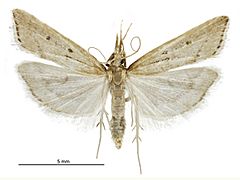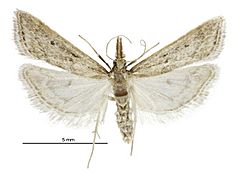Antiscopa elaphra facts for kids
Quick facts for kids Antiscopa elaphra |
|
|---|---|
 |
|
| Male | |
 |
|
| Female | |
| Scientific classification | |
| Kingdom: | |
| Phylum: | |
| Class: | |
| Order: | |
| Family: | |
| Genus: |
Antiscopa
|
| Species: |
A. elaphra
|
| Binomial name | |
| Antiscopa elaphra (Meyrick, 1884)
|
|
| Synonyms | |
|
|
The Antiscopa elaphra is a small moth that belongs to the Crambidae family. It was first described by a scientist named Edward Meyrick in 1884. He found specimens of this moth near Palmerston North and Christchurch in New Zealand. This moth is special because it is endemic to New Zealand, meaning it is found nowhere else in the world.
About the Antiscopa elaphra Moth
The Antiscopa elaphra is a fascinating insect. It's a type of moth, which is a flying insect related to butterflies. Moths are known for their fuzzy bodies and wings that often have cool patterns. This particular moth is part of the Crambidae family, which includes many different kinds of snout moths and grass moths.
What Does It Look Like?
The Antiscopa elaphra is a small moth. Its wingspan (the distance from one wingtip to the other when the wings are spread out) is usually between 12 and 14 millimeters. That's about half an inch!
Its front wings are a pale brownish-yellow color. They have tiny white specks along the veins, which are like the small lines you see on a leaf. There are also some scattered dark brown scales. The part near the body at the front edge of the wing is a bit darker. You might also see some blackish spots before the first white line on the wing. This first line is white and has a dark brown edge behind it.
The second line on the wing is also whitish and has a dark edge in front of it. The back wings of the moth are grayish-white. They have a gray crescent-shaped mark, a gray line further down the wing, and a gray edge.
When Can You See Them?
Adult Antiscopa elaphra moths have been seen flying around in March. This is when they are active and can be observed in their natural habitat in New Zealand.

